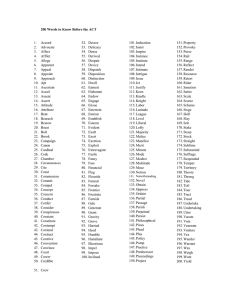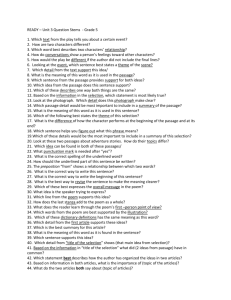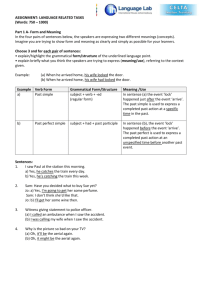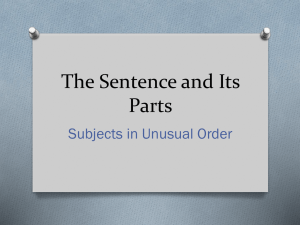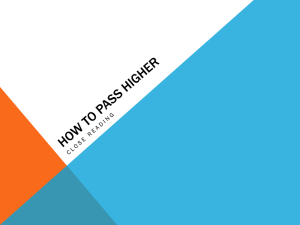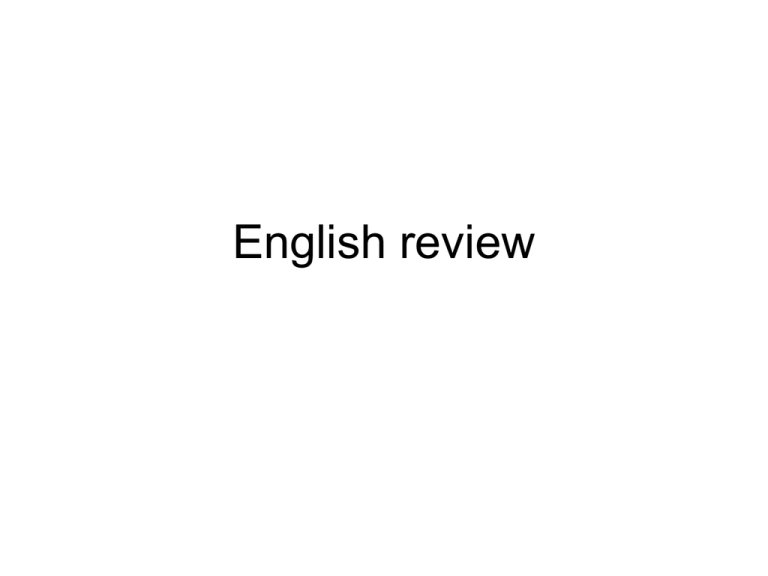
English review
• How many questions?
75
• How long is it?
45 minutes = 9 minutes/passage
• What does it test?
Standard Written English which is different
from conversation
• What concepts are covered?
• Usage and Mechanics
punctuation
commas
apostrophes
colons/semi-colons
parentheses/dashes
periods/question marks/explanation pts
**In your choices, the words will usually be the same, but
the punctuation will be different
• What concepts are covered, continued
• Grammar and Usage
Subject/verb agreement
Pronoun antecedent agreement
Adjective/adverb usage with nouns and pronouns
Verb tenses
Pronoun forms/cases
Comparative/superlative modifiers
Idioms
• What concepts are covered, continued
• Sentence structure
subordinate/dependent clauses
run-on sentences
comma splices
sentence fragments
misplaced modifiers
shifts in construction
• What concepts are covered, continued
• Rhetorical skills
writing strategies
purpose of writing
organization
order of sentences
coherence/clarity of paragraphs
unity of paragraphs
style of writing
word choice – tone, clarity, economy
• Final clues to the English test
• Read _____ passages
five
• Answer _____ questions on each
fifteen
• Allow _____ minutes per passage
nine
• Final reminders continued
• Read to the end of the sentences and
maybe the sentence beyond the question
to discover the relationship between
sentences/ideas
• ****Substitute each option to discover
the best one****
• Check your answers
Redundancy (Repeating)
• If choices all say the same thing, choose
the shortest answer
– Unnecessary and unessential
– Unnecessary
– Not necessary and not needed
– Not necessary and decidedly unessential
Specific Example
• It the question asks you to provide a
specific example, choose the answer that
is the most descriptive
– Red resisted giving up the couch and bed
– Red disappointed Andrew
– Red caused some difficulties
– Red objected
Yes/No Questions
• When you are given the yes/no question,
decide yes or no before reading any of the
responses. Then read only the two that
pertain and judge their ideas only.
– A. Yes, . . .
– B. Yes, . . .
– C. No, . . .
– D. No, . . .
Similar Answers
• If answers are similar, they cancel each other
out and can’t be the right answer
• If a question asks which one would NOT work –
look for the oddball!
–
–
–
–
When
After
Soon
Because
• When, after, soon = time
• Because = cause/effect
Active / Passive Voice
• Stay in the active voice
– She was elected by her peers. (passive)
– Passive has the people doing the action stuck in a
prepositional phrase
– Her peers elected her president. (active)
Verb Tenses
• Tense of verbs must be consistent
• Check the verb in the sentence above the
one that is in the question = make sure the
one you choose is the same tense
• Present
• Past
• Future
Parallel Structures
• Parallel structure
– Keep items in a list in the same grammatical
structure
•
•
•
•
Lounge, sleep, eating
Lounge, sleep, eat
Lounge, sleep, to eat
Lounge, sleep, is eating
– I used up all of my money riding the roller
coaster and playing the carnival games.
Modifiers
• Watch for dangling and misplaced
modifiers
– Rounding the corner of the track, my shoe fell
off. WRONG!!! The shoe is the subject of the
sentence and the phrase. The shoe rounded
the track??? Instead, use . . .
– As I rounded the track, my shoe fell off.
– My shoe fell off as I rounded the track.
Comparative/Superlative forms
• Most fastest – NO!
• More faster – NO!
Redundant!
• Don’t use est with most
• Don’t use er with more
• Use most or est when comparing 3 or more
• Use more or er when comparing 2
• Use neither when discussing only 1
Pronoun agreement
• Pronouns must agree with the nouns they
are replacing in sex and number
– Jane = she (sex/gender)
– Tom and Jerry = we (number)
– Students = they (number)
Punctuation
• Punctuation
– If a semicolon is used, you must have a complete
sentence on the left and right hand side. Sub verb ;
sub verb
– A colon is used to introduce a formal list. The
following students need to go the office: Jim, John,
etc.
– No colon after a verb. The following students include
Jim, John, etc.
– Can’t join two sentences with just a comma!
• I went to the game, then I went to Joey’s house.
– Comma splices!
– For miscellaneous commas, listen for the natural
pause – if you pause, put in a comma and you’ll be
right most of the time
Contractions
• Don’t get the easy ones wrong!
– It’s = it is
– Who’s = who is
– They’re = they are
– You’re = you are
• These are all two words!!!!!
Tone
• Check the tone/style of the passage
informal – 1st person
formal – 3rd person
*** answers should be consistent with
tone
• When the passage asks you to whether or not a
new sentence or phrase should be added, make
sure the tone matches the rest of the passage.
Irrelevant information
• Many yes/no questions include irrelevant
info in the options. AVOID irrelevant info!!!
Strategy
• Read the passage from the very beginning
to the end of the sentence that has an
underlined section.
• Reread the underlined phrase with each
option in its place – unless the answer is
obvious to you.
• Then read from the underlined part to the
end of the next sentence with an
underlined part.
• Mary Francis Kennedy Fisher said in the
beginning of her first collection of essays,
Serve it Forth, “Now I am going to write a
book. It will be about eating and about
what to eat and about people who eat.”
But their work was much more than that.
Final reminders
• Read to the end of the sentences before answering the
question – sometimes beyond if they ask for
relationships between sentences
• When they ask you to add sentences, need to place
each option in the correct place. Read the sentence
before, then the sentence you are adding, and then the
after it. All three must make sense together
• ****Substitute each option to discover the best one****
• Always guess!
• Check your answers if time permits

